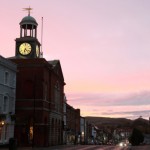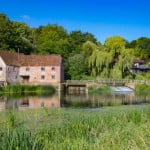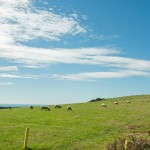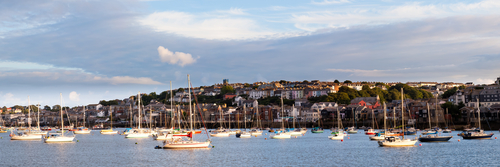
Falmouth is a town and port on the River Fal on the south coast of Cornwall, in southwest England. The town lies some 66 miles (by road) west-south-west of Plymouth. The Cornish port is considered to have one of the best natural harbours in the world. At the 2011 UK census, the town had a recorded population of 21,797.
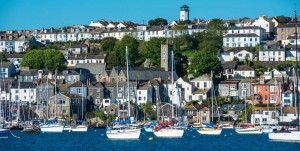
Image: Andy333/Shutterstock.com
Falmouth A Fleeting History
UP until the middle of the 16th century, the only building in Falmouth was the Manor of Arwennack, home to local nobility, the Killigrew family. However, Henry VIII recognised the strategic value of one of the world’s best natural harbours and built Pendennis Castle on the headland. Soon after, another fortification was built across the bay at St Mawes. Around the start of the 17th century, the Killigrew’s set about the development of a port and settlement in the Falmouth area.
However, nearby Penryn was already the main market town in the district, a privilege it had enjoyed since the 13th century. The settlement was originally known as Smithwick or alternatively by the Celtic name of Pny-cwm-cuic (Head of the Creek), that name itself sometimes being anglicised to Penny-cum-quick.
In 1661, Charles II granted a charter to the rapidly developing Falmouth in recognition of land donated by the Killigrews to the church. The new church was to be dedicated to the executed Charles I, father of Charles II and named the Church of King Charles the Martyr. The townsfolk of both Penryn and Truro were against the charter for obvious reasons but their objections fell on deaf ears.
Falmouth Mail Services
In 1689, the Falmouth Packet Service was set up with the purpose of delivering mail to and from Britain’s growing empire. The town enjoyed a monopoly for more than 130-years, as overseas mail left or arrived in England, exclusively via the town. The town enjoyed a boom time in both its economy and status and by the end of the 18th century, the service had a fleet of almost 40 ships.
The ships’ crews were all able to get rich, due to the fact that ships employed on government duty enjoyed exclusion from customs and excise searches. This culminated in smuggling, as well as piracy being rife amongst the mail ship fleet. With plenty of monied sailors around the port, Falmouth was able to develop faster than ever. However, bad news arrived in the 1820s, when the very profitable international mail delivery service was taken over by the Admiralty.
With its strategic maritime location, from the 1790s, there were around 10 Royal Navy frigates stationed here. The Anglo-French Wars of the late 18th and early 19th centuries saw two large camps for the French prisoners being set up at Tregellick and Roscrow, near Penryn.
The Battle of Trafalgar
In 1805, news of Britain’s great naval victory at Trafalgar, along with the sad death of Admiral Nelson, was landed at Falmouth and immediately taken on to London by stagecoach. On 2 October 1836, HMS Beagle anchored here at the end of its famous five-year naturalist study, a voyage that had taken him around the world.
In 1839, Falmouth was in the spotlight as being the site of the ‘Great Gold Dust Robbery’. A shipping clerk was able to intercept £4,600 worth of gold dust that was on its way from Brazil to London. The value of the gold dust would be around £500,000 at today’s prices and thus the robbery was big news. Lewin Casper had enrolled the help of his father Ellis in an attempt to steal the gold but the pair got caught and ended up being transported to a penal colony in Tasmania.
In 1863, the good times were about to roll again for the citizens of Falmouth. This was brought about by the advent of the national rail network reaching the town. The event kicked off a massive boom in the tourist trade as the town now enjoyed good connectivity with much of the rest of the country for the first time. Falmouth responded quickly to the new opportunity, with its first purpose-built hotel opening in 1865, and bathing facilities being opened at Swanpool, Gyllyngvase and Maenporth.
Train Station Two
In July 1925, Falmouth’s second railway station, ‘Penmere’ opened, lying just to the North of the town, it is within easy walking distance of ‘the moors’.
The docks were busy supporting the war effort during both World Wars, with the admiralty taking control of operations. During World War II, it was not unusual to see upwards of a hundred ships anchored around the coast of Falmouth. However, this obviously made the town a target for the Luftwaffe, whose bombs saw a total of thirty-one people lose their lives. Between 1943 and 1944, Falmouth saw the arrival of thousands of American troops preparing for the D-Day invasion.
Modern Falmouth
In December 1970, a third railway station opened in Falmouth close to the National Maritime Museum Cornwall, the waterfront, and the town centre.
Today, while the sea is still important to the local economy, the docklands only employ a fraction of the 3,000+ peak workforce of the 1950s. Tourism is increasingly taking over from trade and commerce as the principal drivers of the local economy.
There are some great beaches in Falmouth’s and many of the town’s large hotels are located close by. Falmouth is also home to a thriving art school, which holds regular exhibitions. There are also many ‘traditional’ pubs in Falmouth, many of which serve food with some also offering live music. The Falmouth Arts Centre is a venue for film and theatre and the Princess Pavilion hosts variety shows during the summer season. Falmouth is also a good centre for anyone wishing to explore this part of Cornwall.
Getting To Falmouth
So If you fancy visiting Cornwall and this lovely seaside town in particular here’s how…
By Train
Great Western Rail operates direct train services from London Paddington, South Wales and Scotland to Truro. There’s also a sleeper service from London Paddington. There’s a train every 30 minutes on the Maritime Line between Truro and Falmouth which takes approximately 20 minutes.
By Bus
National Express serves Falmouth from destinations throughout the UK. Connecting services are available from Bristol, Birmingham and London.
By Road
The easiest road route into Cornwall is via the M5 Motorway. Take the M5 to Exeter, then keep straight-on to take the A30 over Bodmin Moor. Turn off the A30 at the Carland Cross taking the A39 to Truro. Keeping on the A39, take the Truro By-pass and follow the signs for Falmouth, a journey of around 8 miles.
By Air
The nearest airport to Falmouth is Newquay Airport, around 30 miles away. The next nearest regional airport is Exeter, which is 105 miles away. Bristol is the nearest large international airport and situated 182 miles away.
Did you know?
- Falmouth Harbour is the third deepest natural harbour in the world and the deepest in Western Europe
- Up until 1660, Falmouth was known as Smithwick, the name being changed by royal decree
- News of Admiral Nelson’s death was first brought ashore in Falmouth, following the Battle of Trafalgar
-
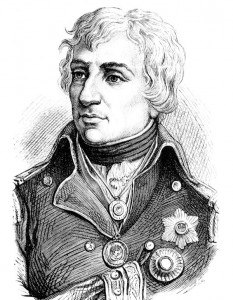
Image: Morphart Creation/Shutterstock.com
Things to see and do!
Henri Lloyd Falmouth Week in August is centred around what is the largest sailing regatta in the South West, which sees a host of activities around the town and harbour. Other festivals celebrated in the town include the Falmouth Oyster Festival in October, a 3-day showcase of Cornish seafood. A couple of weeks later is the Falmouth Beer Festival. There is the Fish Festival in May, followed by June the world-renowned Falmouth Sea Shanty Festival in June.
Some of the recommended things to see and do around Falmouth are:
- Pendennis Castle – positioned on a strategic headland it was built by Henry VIII to defend the important nearby harbour
- National Maritime Museum – 12 galleries set over three floors and an extensive library covering the nautical history of the area
- Gyllyngvase Beach – one of two good beaches within easy walking distance of the town centre
- Trebah Gardens – 3 miles from Falmouth, exotic gardens which include Banana, Lemon and Eucalyptus trees and numerous palms
- Fal Estuary Boat Trip – an hour or more trip, taking in scenic riverside views, historic houses and local wildlife
- Kennal Vale – Cornwall Wildlife Trust nature reserve with picturesque woodland, open glades and an old water-filled quarry
- Kernow Adventure Park – outdoor activity centre with an Aquapark, open water swimming, wakeboarding and paddleboarding
Where to stay?
Accommodation options range from city centre hotels to family farm bed and breakfast places. Self-catering, holiday let and campsite accommodation is fairly limited around Falmouth itself, but is widely available further afield. Thus, there’s something in the area to suit most tastes and budgets. A broad indication of prices for commonly available accommodation in Falmouth is:
B & B/Guesthouses: £60 – £80
Standard Hotels/Inns £80 – £100
3/4/5 Star Hotels £100 – £200
Take the Falmouth Quiz


